Archive for ‘Holidays’ Category
Clutter-Free Holiday Gifts for the Weird Year of 2020 (Part 1): New Twists on Old Favorites

You don’t need anyone to tell you that 2020 was a year like no other. And as we zoom (and Zoom) into the holiday season, some aspects of the gift-giving experience are as fraught as the living-through-this-year experience has been.
In normal times, we professional organizers encourage clutter-free gifts, particularly gifts of experiences. But these are not normal times. Perhaps you’re finding that approach to be a challenge this year? Maybe you’d like someone to tell you how you can make the holidays feel special given that so many gift options are not available for those trying to lead as safe a life as possible.
To that end, today’s post looks at options all across the spectrum and offers virtual alternatives to in-person experiences whenever possible. Consider these clutter-free gift suggestions:
EDUCATION
Advice for a normal year: Once learned, knowledge and skills are forever. Usually, my advice is that you consider lessons in cooking, music, or self-defense. Pre-pay for classes in ballroom dance, quilting, horseback riding, driver’s education, scrapbooking or whatever delights your recipient. The options are practically endless, bounded only by the offerings in your recipient’s community.
But in 2020? Well, educational opportunities still abound, but the best educational options are going to be virtual. Let’s say your recipient loves to cook (or, conversely, hates to cook, but likes the idea of becoming more adept in the kitchen). A virtual course, completely online, is going to be safer (and likely, more accessible) than in-person cooking classes.

For example, consider signing your recipient up a gift subscription for live or on-demand courses from chefs like Serena Wolf of Domesticate.Me. For $29.99/month (and there are also 3-, 6-, and 12-month options), membership in Serena’s cooking club gives you an all-access pass to her live and on-demand courses. (Note: All of Serena’s classes are free to healthcare workers.)
Ali Stafford, author of Bread Toast Crumbs, the Alexandra’s Kitchen blogger, offers similar $29/month memberships with multi-month packages for twice-monthly live cooking classes plus on-demand classes, as well as a $50 package for her book plus one live class. Portion of the proceeds from her classes goes to charity, including $4,000 each to Food Corps, The Okra Project, and Matahari Justice, as well as $1250 to the Hopewell Fund.
Want more variety in instructors? How about online classes from the League of Kitchens, Goldbelly Live! Cook-Alongs, or Sur La Table?
To support local venues, enter the type of class you’re seeking, your locale, and the word “virtual” to see who is offering classes or course memberships in your area.
Perhaps your giftee would like to learn a new language? Options range in price and style from Duolingo Plus (via an Apple or Google Play gift card) to 3 or 12 months or a lifetime of Rosetta Stone to Plimseur e-Gift certificates.
Not sure what kind of classes your BFF or M-I-L would like? MasterClass has you covered with a wide variety of options in the arts, sciences, business, and more. You can purchase a gift of one class or an annual membership pass, granting your recipient access to any/all of MasterClass’s 90+ instructors.
Joyce Carol Oates, Aaron Sorkin, Judy Blume, and James Patterson teach writing. Got some STEM learners on your list? Dr. Jane Goodall, astronaut Chris Hadfield, and Neil DeGrasse Tyson teach science conservation, space exploration, and scientific thinking and communication, respectively. Would your giftee appreciate learning acting from Helen Mirren and Natalie Portman, or perhaps they’d want more cooking advice, perhaps from Gordon Ramsay or Alice Waters?
FYI, for a limited time only (through December 28, 2020), there are two special deals. First, there’s a Holiday 2020 “Give One Annual Membership, Get One Free” deal. Also, current/active MasterClass members can give the gift of a MasterClass Annual Membership for 30% off the current rate.
ENTERTAINMENT
Advice for a normal year? We professional organizers always encourage experiential gifts over tangible ones because research shows that experiences are more memorable than possessions. Compare what you remember about your last vacation vs. what you received for your last birthday or holiday, and you’ll see why. Experiences are personal and vivid in ways that tangible gifts often are not. So, my traditonal advice for gifts of entertainment runs along these lines:
Buy your loved ones tickets to sporting events, concerts, or comedy clubs; take them to the symphony, a lecture series, or a theater event. Check out local community theaters, universities, and even high school schedules for their music and entertainment offerings. From a booklet of movie tickets to a Broadway show, their memories will live onafter the big holiday night or Christmas morning.
But in 2020? To stay safe and protect our loved ones, most of us are not attending sporting events, concerts, or comedy clubs. We’re not going to movies or theaters. Luckily, technology still gives us plenty of gift options.
Buying for TV and movie fans? Gift someone three months or a year of Amazon Prime, buy them a gift card for Netflix, or a monthly or yearly subscription to Hulu if you want to stick with the big guns. Or you could buy gifts of individual channels like Disney+ (for friends with kids or fans of Marvel movies), CBS All-Access (for those who love Star Trek), or Acorn or BritBox for fans of shows from the UK. Almost any streaming service offers a gift option, so a little searching may find you programming your recipient didn’t even know existed!
For serious cinephiles, The Criterion Channel might be your best bet, with gift subscriptions ranging from one to nine months or for a full year. Criterion brings your movie buff one thousand “important” classic and contemporary films, plus a constantly updated selection of Hollywood, international, art-house, and independent films from major studios and independent distributors.
Maybe your recipients prefer stage performances to cinemas? To keep them entertained, from Shakespeare to Hamilton, comedies to dramas, Ibsen to Spongebob (the musical), consider a monthly or annual gift subscription to BroadwayHD, ranging from $8.99/month to $99.99/year.
For music-oriented recipients, 2020 has little in the way of safe live events, but streaming music services abound. Consider gifting your loved ones premium levels of something like Spotify, Amazon Music, Deezer (yeah, I’ve never heard of it either, but apparently it covers the globe and has 35 million songs), or Tidal.
PRACTICALITY
Advice for a normal year? Any drivers on your “nice” list would benefit from gift certificates for oil changes, car washes or detailing, and even annual memberships in AAA or their favorite auto club. Unlike the streaming services mentioned above, you can’t usually get a gift certificate for multiple months of internet, cable, satellite, or cellular service but you could gift your recipient cash earmarked for pre-paying those services. It’s practical, because it means your giftees will have extra pocket money to spend something fun that just pops up during the year. So, in the practical realm, the usual advice holds.
Special tip for 2020: In a year where many of our friends and family members, especially those with more delicate constitutions, are staying close to home, grocery delivery has become an important service. Depending on the availability in your giftees’ areas, consider gift cards for Instacart or Shipt (which is currently offering 50% off an annual membership for unlimited same-day deliveries, available through 12/27/20). Individual national and regional grocery stores, like Walmart, Aldi, Safeway, Publix, and Wegmans have their own services with gift options.
 Iangelidaki, CC BY-SA 4.0, via Wikimedia Commons
Iangelidaki, CC BY-SA 4.0, via Wikimedia Commons
ADVENTURE
Advice for a normal year? In past years, I’ve advised: For the thrill-lovers on your list, choose certificates for hot-air balloon or zip lines. For racing lovers, try a ride-along at the NASCAR Racing Experience program or Daytona Speedway course. Athletes appreciate a week of baseball fantasy camp, pre-paid rounds of golf, and time in the batting cages.
But in 2020? I’m not sure what “adventure” really means to us in 2020, as even adventures that don’t require close contact with others usually require travel to get where you’re adventuring. Note that many of the usual adventure venues currently have “COVID guarantees” promising refunds if the activity isn’t available due to regulations or restrictions for 12 months from the date of purchase, so be sure to check. Consider gifts that allow for adventures with a social distancing component, like an annual National Parks Pass to explore the country’s great natural beauty and experience some elbow room.

PAMPERING
Advice for a normal year? In past years, to gift anyone with too much stress, I’ve advised: gift certificates for haircuts and styling, spa facials, or a massage. Many day spas have special packages for sportsmen and for teenagers (boys, as well as girls), gifts that most people are unlikely to purchase for themselves. For a friend struggling to quit smoking or lose weight, pre-paid sessions with a hypnotherapist or acupuncturist might be the offbeat support that helps them conquer their troubles. For a more lavish gift, consider a 3-month gym memberships or a night at a cozy bed & breakfast.
But in 2020? Yeah, gym memberships, nights at B&Bs, and spa days are on hold for most of us for a little longer. But that doesn’t mean you can’t give the gift of self-care without clutter. In addition to consumables (like spa and bath products), consider items that help your loved ones be their best selves. Fitness trackers, like Fitbit, make a good “big” gift for the outer self, and apps like Calm and Shine are good virtual stocking stuffers to nurture the inner self.
CONSUMABLES
Advice for a normal year? Let’s face it — dining is the ultimate clutter-free experience. By the end, the only clutter is the wrapping (and perhaps the extra calories). You can send one-time or subscription gifts for almost every food type you can imagine: cheese, fruit, vegetables, steaks, cookies, and more.
A few great options are Harry & David, Russ & Daughters, Goldbelly (shipping local restaurant delights nationwide), Mouth, and my personal favorite, Zingerman’s. (Editor’s note: Friend of the blog Linda Samuels recommends the artisanal fruits and preserves from American Spoon, so I’ve added that link, too.) If you don’t know what someone likes to eat, there are always gifts of ingredients, like spices from Penzeys, or hot sauce gift boxes from Fuegobox.

But for 2020? Let’s be real. We’ve been eating all year. We’ll be eating next year. Nobody is going to complain if you gift them with something they find delicious. As Paper Mommy would say, “Eat and be well!”
While gifts of experiences are key to having memorable holidays, we know that there are people on your list who want something they can hold in their hands. We have two more installments of Clutter-Free Holiday Gifts for the Weird Year of 2020. We’re going to look at gifts you can give to loved ones that also give back to others, and gifts that can make life more organized.
Paper Doll Wraps Up the Holiday Season (Sneakily, Diagonally, and Intangibly)

Welcome to the home stretch of the holiday season.
Maybe you’re reading this while standing in a long line because this is the first chance you’ve had to shop and you were shocked to find that your favorite online store sold out of the only thing on your special person’s list.
Perhaps you bought all your presents last summer, wrapped and labeled them, and stored them in your secret hiding place months ago.
Either way, how are you going to keep the gifts a surprise until unwrapping time?
HIDING PLACES
I think the best place to keep gifts, wrapped or otherwise, from the prying eyes of tiny humans and others with insatiable curiosity is in an old suitcase. People will check under beds and in closets, but nobody looks in those cheerless valises in the basement, the ones that are faux leather and lack wheels and haven’t been used in 40+ years.
Yes, as a professional organizer, I encourage people to donate or recycle things that they don’t use, but quietly repurposing that blue suitcase circa 1978 counts as recycling!
Other options worth considering:
- Hidden in plain site — Would your kids (or your spouse) show any interest in prying up the lid of a Bankers Box labeled “2015 Tax Receipts,” “college textbooks,” or something similarly boring? Probably not. (Piling other stuff on top couldn’t hurt.) If you’re the only one in your house who cooks, a small wrapped gift or two hidden in the back of a kitchen cabinet, inside a rarely-used fondue pot, may be just what you need to stymie the sneaky searchers.
- Your friends’ & neighbors’ houses — One solution is just to trade storage. Take your wrapped gifts in boxes or lidded tubs to your cousin’s, co-worker’s, or BFF’s place, and return with hers. You can even tell your family not to bother snooping because you’ve made this trade. (Note: if your kids and their kids are friends, one may spy on the other’s behalf.)
- The trunk of your car — Obviously, this works in only two situations, when you normally have an incredibly tidy trunk (with ample room to store a gift-filled box labeled “work project”) or if you normally have a predictably packed and untidy trunk (in which case you need to hollow it out and hide gifts underneath the faux facade of mess. (Do not mark any boxes as “donations” or someone may unhelpfully deliver all your holiday gifts to charity!)
- Attics — The upside is that children and pets generally can’t get up to the attic on their own. The downside? It’s probably not that easy for you to get up there, either. Also, it’s probably dusty, there may be “critters” and there’s almost certainly temperature and humidity variations throughout the year. Keep that in mind if you’re storing any gifts that are sensitive to those kinds of changes, and store the gifts in a tightly lidded tub.
- Laundry hamper — Let’s face it; nobody is enthusiastic about doing laundry. Your kids aren’t about to suddenly volunteer to take the laundry from your room, even to please Santa.
- Trash bags — Big, black trash bags or leaf bags, especially if you have an attic, or garage, or basement with a variety of things already obscured by bags, may be the ticket. The problem? If there’s anyone who ever visits your house trying to be “helpful,” they may assume it’s trash and toss it out.
If your storage is at a premium and you have to keep wrapped gifts out and on display — and this trick works once you’re ready to put the gifts under the tree — fake the name tags. Instead of Mom, Dad, Aunt Jen, etc., make yourself a cheat sheet matching real names to “gift” names and put presents out for Lizzo, Daenerys, Baby Yoda, and so on.
WRAPPING SAVVY
Paper Doll is terrible at wrapping any gifts that don’t come in perfectly rectangular shapes. Back in NAPO2014: It’s a Wrap! Organizing Your Wrapping Supplies with Wrap It!, I told a story of my wrapping failures (and shared this adorable photo of a now-late-20s young man).

Many years ago, I offered up some alternatives for people with wrapping skill deficits:
It’s a Wrap! Wrapping Paper Alternatives, Furoshiki & Frogs (2008)
Paper Doll Wraps Up the Holidays and Makes It All Stick (Part 1) (2011)
Paper Doll Wraps Up Some Alternatives to Wrapping Paper (Part 2) (2011)
I’m obviously not the only person who has trouble wrapping presents, because the hottest video on the internet in the past few weeks has been one that went viral with ways to wrap gifts in unusual ways, and especially spotlighting wrapping gifts diagonally.
In case you haven’t seen it, be sure to press PLAY below and crank the volume. Oh, and stop by @BlossomHacks to give them some love. As often happens on the internet, credit got lost along the way, and most people were not aware that Blossom DIY created the video (which UK bookseller Waterstones made viral).
Wrapping gifts got a whole lot easier with these clever ideas! pic.twitter.com/sP4MXhpBBu
— Blossom (@BlossomHacks) December 14, 2019
By the way, if you care, Popular Mechanics has a feature on the math behind the diagonal wrapping hack.
WRAPPING and PACKING and SHIPPING, OH MY!
Finally, I’m an organizing and productivity expert, not a wrapping, packing, and shipping expert (my recent post, This “Magic” Product Makes Shipping Packages as Easy as Wrapping Leftovers, notwithstanding).
Luckily, our friends at Quill have more expertise on these issues and have been kind enough to share their infographic to take you through each of these holiday headaches with aplomb.
 Gift wrapping, packing, and shipping hacks to save money and make your life easierInfographic by Quill
Gift wrapping, packing, and shipping hacks to save money and make your life easierInfographic by Quill
A FINAL WORD
Of course, the best gifts don’t necessarily need to be wrapped or shipped. As we’ve talked about many times, gifts don’t need to be things at all.
We’ve spoken many times about how you can give gifts of experiences. Consider adventures (like the NASCAR Racing Experience or an afternoon in an escape room), entertainment (tickets to sporting events, museum exhibits, concerts, theater events, six months of Netflix or Hulu, or a year of Amazon Prime), practicality (gift certificates for car washes or an auto club membership like AAA), or consumables (homemade or subscription-based, or gift certificates to restaurants or coffee houses). And, of course, gifts of organization and productivity never go amiss.
Happy holidays, and I hope whatever you give (and receive) gifts makes life a little (or a lot) more joyous.
This “Magic” Product Makes Shipping Packages as Easy as Wrapping Leftovers
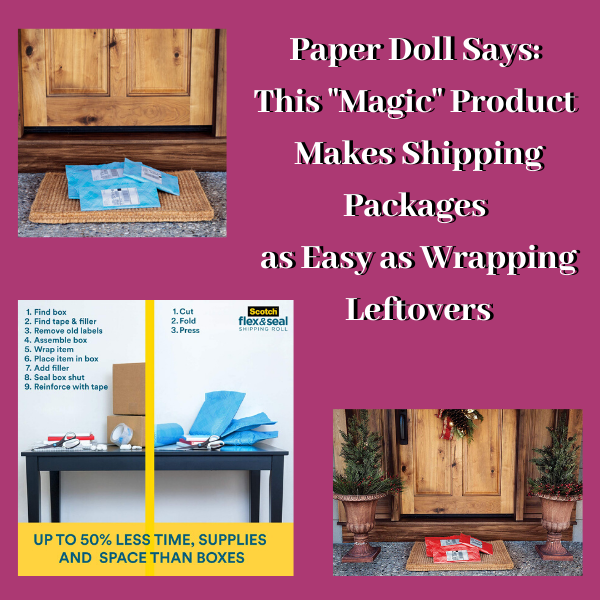 Packing and shipping is not exactly rocket science. And yet Paper Doll hears a lot about shipping-avoidance and packing-box frustration. In a perfect world, whenever we wanted to ship something, we’d have the ideal sized box (so as not to waste space, and also not to have one of those almost-sealed, bulging boxes where the flaps quite don’t meet). We’d also have just the right amount of padding material to prevent jostling, and it would all be easily recyclable.
Packing and shipping is not exactly rocket science. And yet Paper Doll hears a lot about shipping-avoidance and packing-box frustration. In a perfect world, whenever we wanted to ship something, we’d have the ideal sized box (so as not to waste space, and also not to have one of those almost-sealed, bulging boxes where the flaps quite don’t meet). We’d also have just the right amount of padding material to prevent jostling, and it would all be easily recyclable.
My clients tell me they procrastinate on returning purchases and shipping care packages, birthday gifts, and other things because – although they have lots of boxes and bubble mailers thanks to their online shopping habits – nothing is ever the right size. This isn’t just a frustration; it’s also a financial issue.
In 2015, the major players in the ground shipping world, like UPS and FedEx, stopped pricing solely by the pound. They realized that a lot of relatively light packages were being shipped, and that cost them money. So, they started using dimensional weight, which had already been the practice for air-shipped packages.
What is dimensional weight?
The shipper calculates the cubic size of a package by multiplying its length, width, and height. Once the dimensional weight is calculated, they compare it to the actual weight of the package and the larger of the two is used to determine the package’s actual “billable” weight.
Need some help with the math? Google dimensional weight shipping calculators, like this one from ShippingEasy.com.
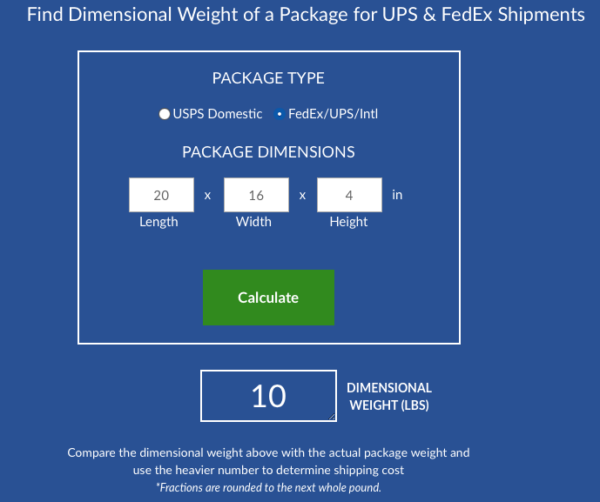
What does this all mean for you? A small thing in a bigger box will cost you more than that same thing in a smaller box, which means you have to keep even more shipping supplies on hand to find the just-right solution, and that causes clutter.
If only someone had a better idea. Oh, wait. Someone did!
SCOTCH™ FLEX & SEAL SHIPPING ROLL
3M is a marvel of innovation. The same parent company that brought us Post-It® Notes and Command hooks has done it again. They’ve invented a shipping solution that requires keeping less packing material and fewer supplies, takes less time, and creates a smaller dimensional weight for the things you ship.
And, honestly, I’m not persuaded that it isn’t some kind of magic.
Scotch™ Flex & Seal Shipping Roll
First, let’s get an overview of the product, with some fun, bouncy music.
Cool, eh? So, let’s dig deeper. How does this product save space, time, and money?
Eliminate clutter
What do you keep on hand for shipping packages? Boxes, right? Probably lots and lots of Amazon (and other) boxes. Maybe USPS “priority” boxes (which always seem to be way too large or just a little too shallow)? A family member bought a gorgeous Kitchenaid stand mixer and had it shipped. It came in a glossy, specially-carved Kitchenaid box (with a photo of the mixer on the package) inside a matching, plain, cardboard Kitchenaid-branded box (each with specially-placed handles for ergonomic carriage) and the whole thing was inside a box that would have made a nice toddler playhouse.
I bet you don’t just hoard boxes. I bet you have bubble wrap. (And not nice rolls of bubble wrap, but pre-used bubble wrap that someone in your house has popped and flattened along the edges, right?) Or maybe you have styrofoam peanuts. Or those clear, little balloons that look like nothing so much as an inflated zip-lock sandwich bag without the zipper?
And where are you storing these cardboard boxes, bubble mailers, poly bags, bubble wrap, and package stuffing? Probably wherever you can find to put it, and likely not in a very sound system. (No, I’m not peeking in your windows while you’re sleeping. Promise!)
Because the Flex & Seal allows you to customize your package to fit precisely around the edges of your item, there’s no wasted space in the box and no unnecessary padding to keep on-hand. Scotch’s marketing claims to save up to 50% on supplies, time, and space vs. using boxes. I don’t know how they arrived at that statistic, but it does mean that you can take up less space, and the roll can be stored horizontally or vertically, like a rolled-up yoga mat.
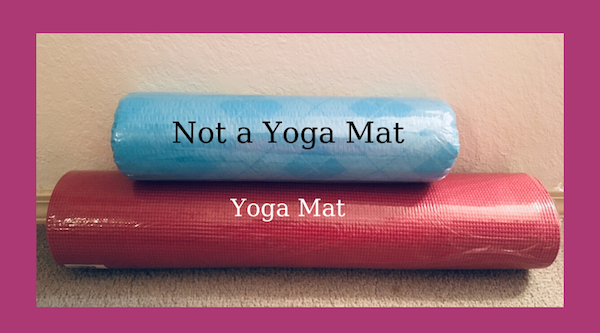
Save time
My clients are invariably piling up to-be-shipped items on the dining room table or on kitchen counters because they anticipate (often correctly) that it will be time-consuming to find a suitably-sized box, pad and pack the item(s) safely, and seal everything confidently. Scotch™ Flex & Seal Shipping Roll promises make packing as simple as:
- Cut a piece of the roll long enough to sandwich the item you’re shipping.
- Fold the Flex & Seal over whatever you’re shipping.
- Press to seal it by continuing to press around the three (non-folded) edges. (Imagine you’re wrapping your Thanksgiving leftovers in aluminum foil before putting them in the freezer. Or, as the product’s web site says, “Make sure you’re pressing gray surface to gray surface. A helpful way to remember it: Do not wrap like a present, fold and press like a calzone!”)
That’s it. Print out your label and affix it to the package. Wheeeee!
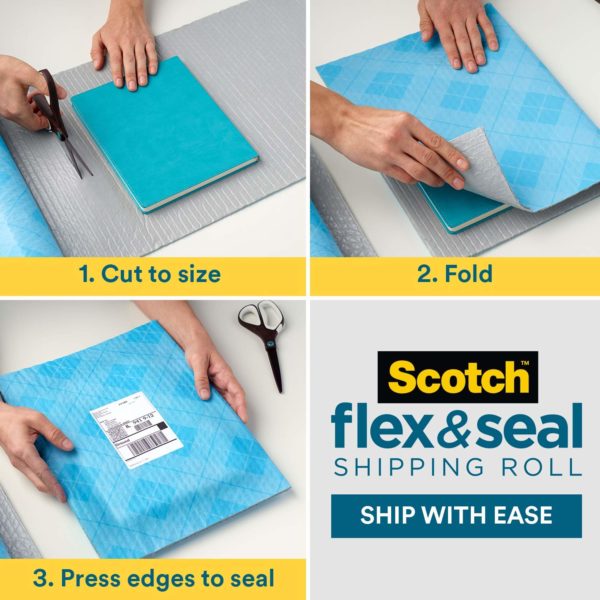
Secure and immobilize your package.
Scotch™ Flex & Seal Shipping Roll may look like a prettier version of bubble wrap, but it harbors a secret superpower. Flex & Seal is constructed with three layers.
The blue outer layer is tough and durable, making the package water-resistant and tear-resistant. The clear middle layer is bubble wrap, but seems slightly less inflated (and is difficult to pop), creating firm cushioning for the package.
And the grey inner layer is MAGIC. (OK, I’m sure it’s science, but Paper Doll can’t figure out how it works!) This inner layer’s “adhesive technology” makes it stick securely to itself but not whatever you’re shipping!
Scotch™ Flex & Seal Shipping Roll sticks to itself and not to what you put inside! What kooky shipping witchcraft is this? Share on XOnce you fold the Flex & Seal over your item (sandwiching it), just press firmly for a guaranteed seal. Folded and smushed (for another scientific term), the Flex & Seal conforms to the shape of whatever you’re shipping, immobilizing it to protect against wiggling during shipping.
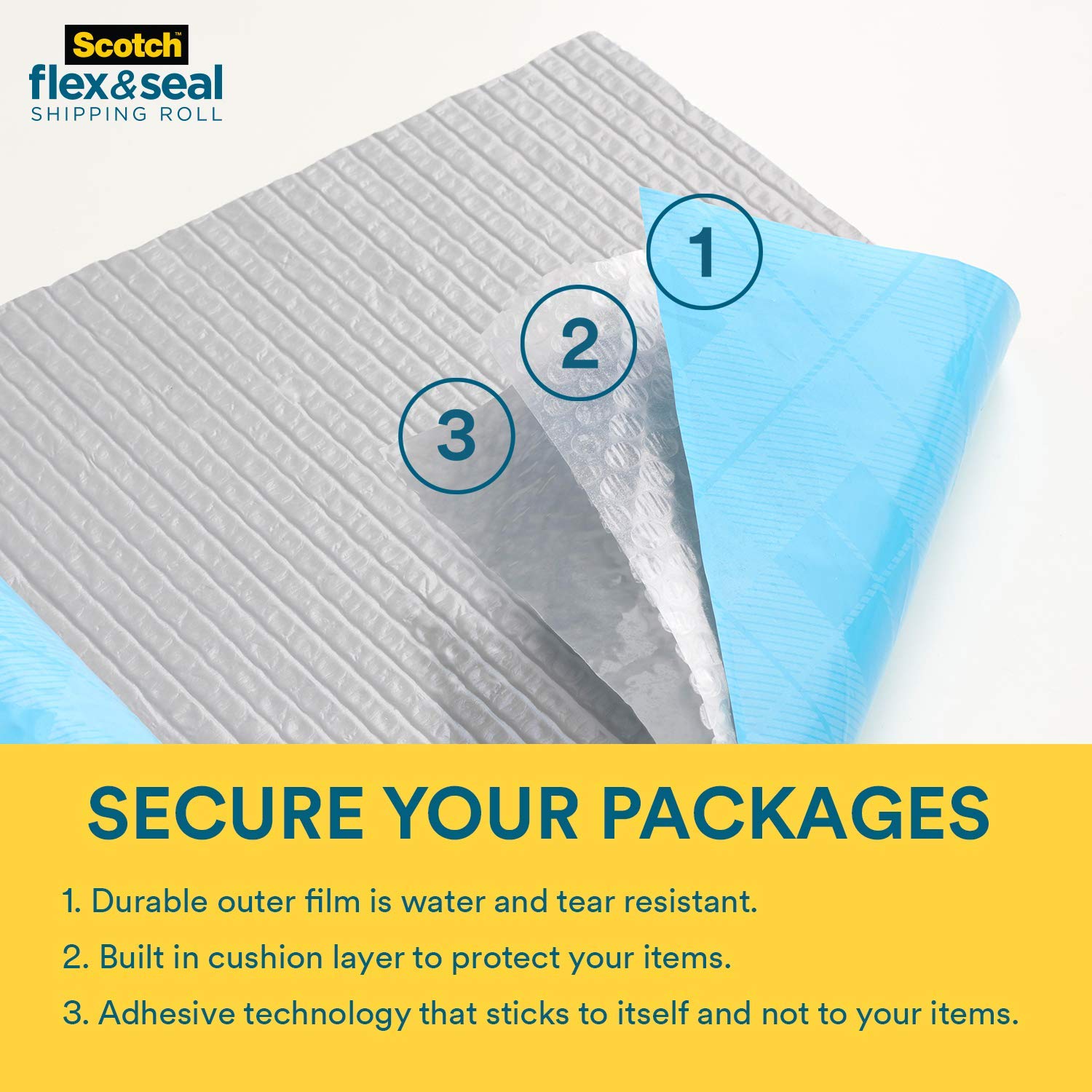
Save money.
The marketing for the Flex & Seal Shipping Roll notes that by eliminating extra packing and shipping supplies, and securely sealing around the shape of whatever you’re shipping, it can reduce the package’s dimensional weight, as we discussed above. That should reduce your costs. Yay!
WHO CAN USE THIS?
Anyone who can comfortably maneuver scissors should be able to use the Flex & Seal. (If you’re doing a LOT of packing, consider a paper cutter in lieu of scissors.) If you – like Paper Doll – sometimes have trouble wrapping presents and fear this might be too similar of an experience, fear not. I’ve been known to unroll too little or too much wrapping paper and then the paper crumples and creases as I try to get just the right amount. Flex & Seal is thicker and sturdier, so that’s not an issue. Also, unlike rolls of wrapping paper, Flex & Seal is only 15″ wide, only a few inches longer than a paper towel roll, so it’s not unwieldy.
So, who can use this?
- People who rarely need to send packages. If you never have boxes or bubble mailers on hand and put off shipping things because you lack room to store them, this makes things pretty easy.
- People who send packages all the time – Grandparents? Check. Crafters who share their creations for fun or profit? Check. Small business owners who ship small, fiddly things? Check. Authors who autograph and ship copies of their books? Check!
When shouldn’t you use Scotch™ Flex & Seal? If you’re shipping something delicate or fragile, stick to a traditional packaging set-up, like a cardboard box with firm but flexible padding and a tight seal. Also, because the inner grey layers must be matched up, it’s not suitable for large packages.
ENVIRONMENTAL ISSUES
Flex & Seal is recyclable. Scotch™ advises just removing the label before dropping the packaging off at a plastic bag recycling location. While not all communities have plastic bag (or plastic film) recycling centers, you can enter your zip code into the search bar at PlasticFilmRecycling.org to find a center near you.
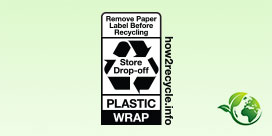
However, I am concerned that not all labels are so easy to peel off. My 10-foot roll of Flex & Seal came to me wrapped in actual Flex & Seal! (How’s that for good advertising? It was very meta.) But both the marketing label (promoting other 3M products) and the UPS label would not peel off cleanly, so I’m not sure if that renders the package un-recycle-able.
HOW TO OPEN FLEX & SEAL PACKAGING
I’ll admit, I was puzzled when my Flex & Seal Shipping Roll (again, wrapped in Flex & Seal) arrived. I saw that I could just cut it open with scissors, but I didn’t want to accidentally cut what was inside. But I also couldn’t just pull on opposite sides of the packaging as if I were opening a bag of potato chips.
In the end, I guessed (correctly), and carefully used the scissors on the corner of the packaging, but I’m betting I wasn’t the only uncertain person, as Scotch™ produced this video to set people straight about three different methods for opening Flex & Seal packaging!
VARIETIES OF FLEX & SEAL SHIPPING ROLL
Scotch™ Flex and Seal Shipping Roll comes in four sizes:
- 10′ long x 15″ wide
- 20′ long x 15″ wide
- 50′ long x 15″ wide
- 200′ long x 15″ wide (suitable for small business shippers or people with LOTS of grandchildren)
As for styling, well, there’s not a lot of variety. The standard is the blue exterior with the grey interior.
Looking for something a bit more festive for the holidays? That regular sky blue is cheery enough (and sorta suitable for Hanukkah) but if you’re looking for something a little more Christmassy, Scotch™ has created a Limited Edition Holiday Color (which you and I may recognize as “red”).
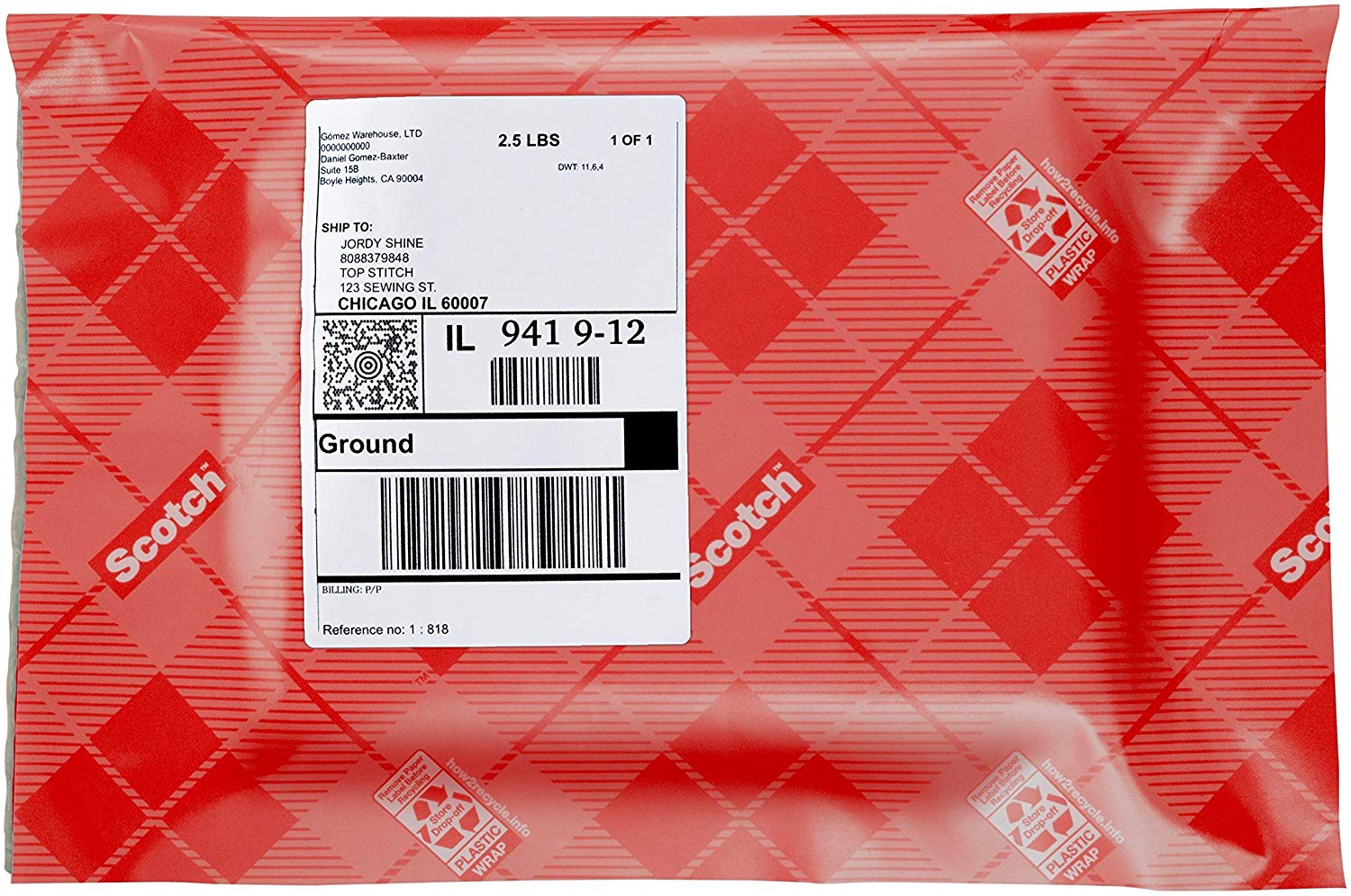
LOCATIONS AND PRICING
Scotch™ Flex & Seal Shipping Roll is available online at Amazon and Shoplet, and at Target, Walmart, Office Depot, and Staples. Prices range from about $8.50 for the 10′ roll to $99 for the 200′ roll.
Disclaimer: As part of a voluntary program, I help 3M evaluate some of their products. 3M sends me free samples and I analyze them, and give my honest opinion on their site. I had just received my 10′ roll when I saw that my colleague Seana Turner had included Flex & Seal in her post, Seana’s Top Gifts for 2019, which gave me the idea to write this post. Be assured that all opinions are my own. (Who else would claim them?)
Avoid the Lost & Found: Keep Track of Your New Goodies with Tile
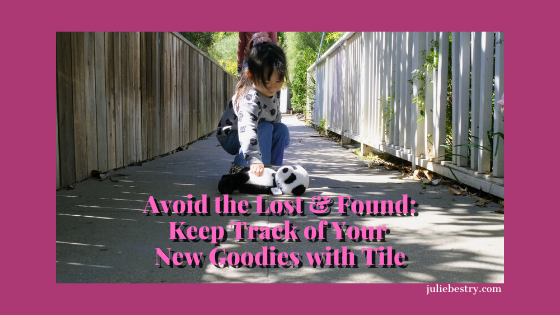
Seek and ye shall find. Or, at least you hope so. But the more stuff you have, the easier it is to lose things.
Earlier this year, Paper Doll shared Bluetooth solutions for keeping track of your gone-missing items in the post Paper Doll Finds Your Lost Keys, Wallets, and Phones: Bluetooth Trackers 2019 and the follow-up, Paper Doll Finds Your Lost Eyeglasses: Technology Beyond Checking the Top of Your Head.
If you are frustrated that your things go missing and you haven’t tried a Bluetooth tracker, this post is for you. With Black Friday, Cyber Monday, and a plethora of holiday gift-shopping situations on the horizon, we are all – ourselves, our families, and all of our recipients – going to have to keep track of stuff and the paraphernalia we need to keep our stuff working. Hence this update post on Tile.
In Paper Doll Finds Your Lost Keys, Wallets, and Phones, we covered Bluetooth basics and the most popular solutions, including Tile. If it’s been a while since you read the post, or you’re new to the world of Bluetooth trackers, I encourage you to revisit that post and see the magic of having tiny doodads keeping track of the things you bury, wander away from, or which wander away from you (in the hands of tiny humans, furry friends, or your last rideshare experience).
Previously, the last line of Tile products offered three main options, the Pro, Mate, and Slim, as it appeared below.
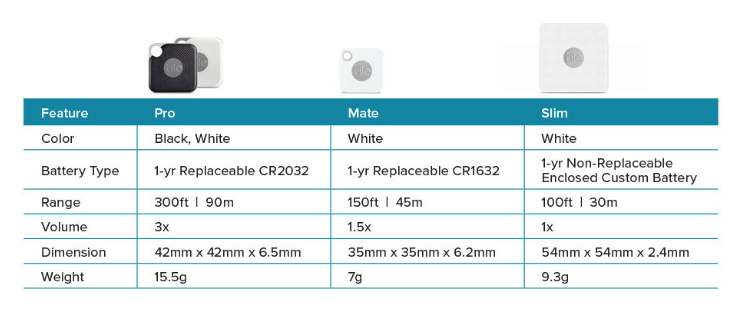
The three designs were different from one another in terms of sizes, Bluetooth ranges, alarm volumes, but all were designed to attach to your possessions (keys, wallets, cameras, umbrellas, fancy water bottles, favorite stuffed animals, backpacks, remote controls, etc.).
The key commonality was that with a quick tap on the app, you could find your lost stuff, and even have it give you a “yoohoo!” (Far from your stuff? As we explained in the original post, Tile’s community of users extends the reach of your search, as if a whole posse of detectives were on the case.)
Recently, Tile introduced a brand-new “hardware” lineup that improves upon the characteristics of the prior projects. Basically, that chart above is “soooo 2019” and the refreshed items include some interesting updates.
TILE SLIM
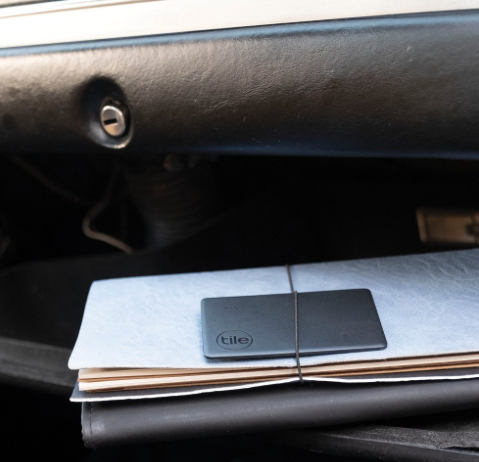
Remember the Tile Slim? (See that old info on the right of the chart?) The NEW Tile Slim has received quite the upgrade! Instead of a flat square, it’s now shaped like a credit card, perfect when you’re looking at a “low-profile” design, like in a wallet or a business card case. (Seriously, have you ever set down your business card case at a conference to shake hands or examine something in an expo or because you’re talking with your hands? No? Just me?)
The Slim is still 2.4mm thick (about the thickness of two credit cards, but wider (86mm instead of 54mm) to fit comfortably in all the places you’d store credit, debit, loyalty, or business cards.
Previously, the Tile Slim had a 1-year built-in (non-replaceable) battery; the battery now lasts three years. The range has been doubled from 100 to 200 feet (from 30 to 61 meters), and has a louder ring to help you find what’s yours more quickly.
The Slim is available in black, only, and costs $29.99.
TILE STICKER
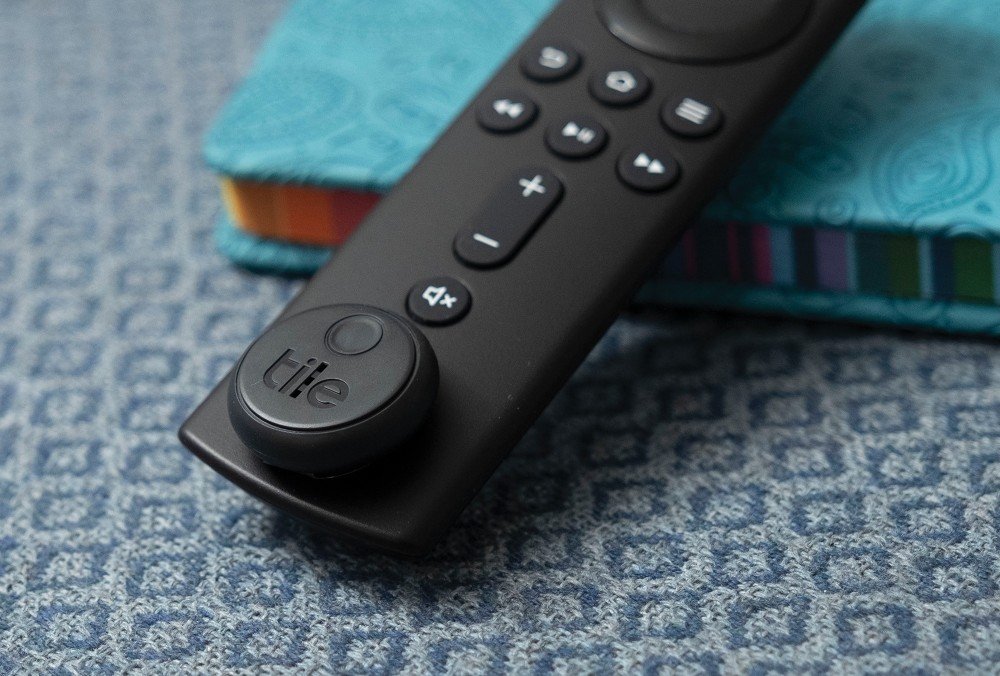
Tile recognized that some stuff is just plain small, and small stuff needs smaller Tiles. Otherwise, your stuff gets lumpy and the “feel” just isn’t right. This led to the new Tile Sticker.
The Sticker is Tile’s smallest tracking solution. These little dots of Bluetooth power are waterproof and adhere to your items with Tile’s time-tested adhesive backing that can stick to anything. (OK, don’t stick it directly on the dog, however often he gets lost! That’s just not cool.)
The Stickers have a 3-year battery life and a range of 150 feet. Like the Slim, the Stickers are only available in Black.
They sell for $39.99 for a 2-pack or $59.99 for a 4-pack.
TILE MATE and PRO (UPDATED)
Tile hasn’t forgotten the rest of their lineup. To round out these improvements, Tile has expanded the Bluetooth range to enable zippier search and more reliable “finding” for both the Tile Mate from 150 to 200 feet (from 45 to 60 meters) and the Tile Pro from 300 to 400 feet (from 90 to 122 meters).
For those who care about styling, the Mate is available in White for $24.99, and the Pro is available in Black or White for $34.99.
HOW TILE WORKS
TILE 2020 LINEUP COMPARED
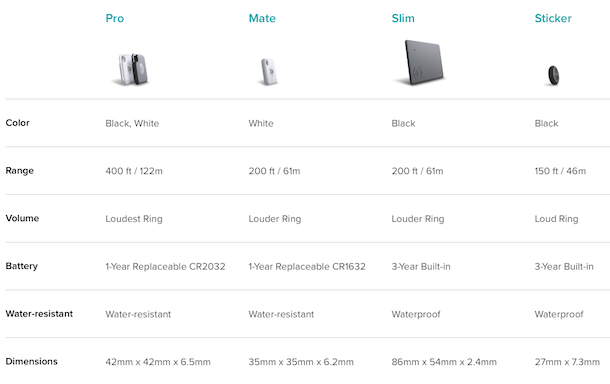
As you can see, the Tile Pro is the only version that gives you a choice of colors, and it has the loudest ring and double the range of any of the other products. But it’s also the thickest.
The Mate is smaller but thicker than the Slim, and you can replace the battery, but (like the Pro) it’s merely water-resistant, not waterproof like the Slim (and the Stickers). But the Mate does have a replaceable battery.
So, depending on each object you want to track, you’ll want to decide what’s the most important feature(s) for you for that object.
HOW TO CHOOSE
Color – Do you need your Tile to blend in with the surroundings? Do you really need to make a fashion statement? If aesthetics are truly your thing, there are always decorative Tile Skins.
Range – Where do you use your stuff? If you’re affixing it to a remote control or something else that never leaves your house, or if you live in a small apartment rather than a McMansion, a huge range may not be as important as it would be for something you schlep to work, school, and the beach.
Volume – As with range, if you’ve got sharp ears (or a child, teenager, or dog with sharp ears), having the loudest alarm may not be important, but if you’re buying Tiles for the great-grandparents or you work or hang out in a loud environment, the Sticker’s volume may not be loud enough for your needs.
Battery – Ah, the eternal debate: a longer-lasting built-in battery or a shorter, replaceable battery? It’s a personal choice, but I know I’d rather replace a battery than a whole device.
Water-resistance – Is your tiny human carrying her backpack through some raindrops or does she like to dump all the remotes in the (filled) bathtub? It’s worth considering.
Dimensions – How big is the “thing” that you don’t want to lose? How concerned are you about style and fit vs. function?
COMBO and MULTI PACKS
Recognizing that few of us need to track merely one thing, Tile has a variety of combo and multi-packs to fit a range of situations. I encourage you to sit down with your holiday gift list and figure out what gifts you’re giving might be augmented by the insurance policy of a Bluetooth tracker like Tile. Then take a reality check in your household and figure out what everyone is always misplacing, and go from there.
Tile Essentials: 2 Tile Stickers, 1 Tile Slim, 1 Tile Mate available for $69.99
Tile Pro Combo: 2-Pack (one black, one white) at $59.99 and 4-Pack (two black, two white) at $99.99
Tile Mate: 4-Pack for $69.99
Tile Mate/Slim Combo: 2 Mates and 2 Slims, available for $74.99
GOOGLE NEST
In October, Tile partnered with Google to make search even easier via the Google Nest device. So, if you’ve got a Google Nest (formerly Google Home), instead of using your phone and the Tile app, you can ask your Google Assistant to yoohoo your Tile devices for you. So, if you say, “Hey Google, make my wallet ring!” it’ll do that for you. (The 21st century is weird that way.)
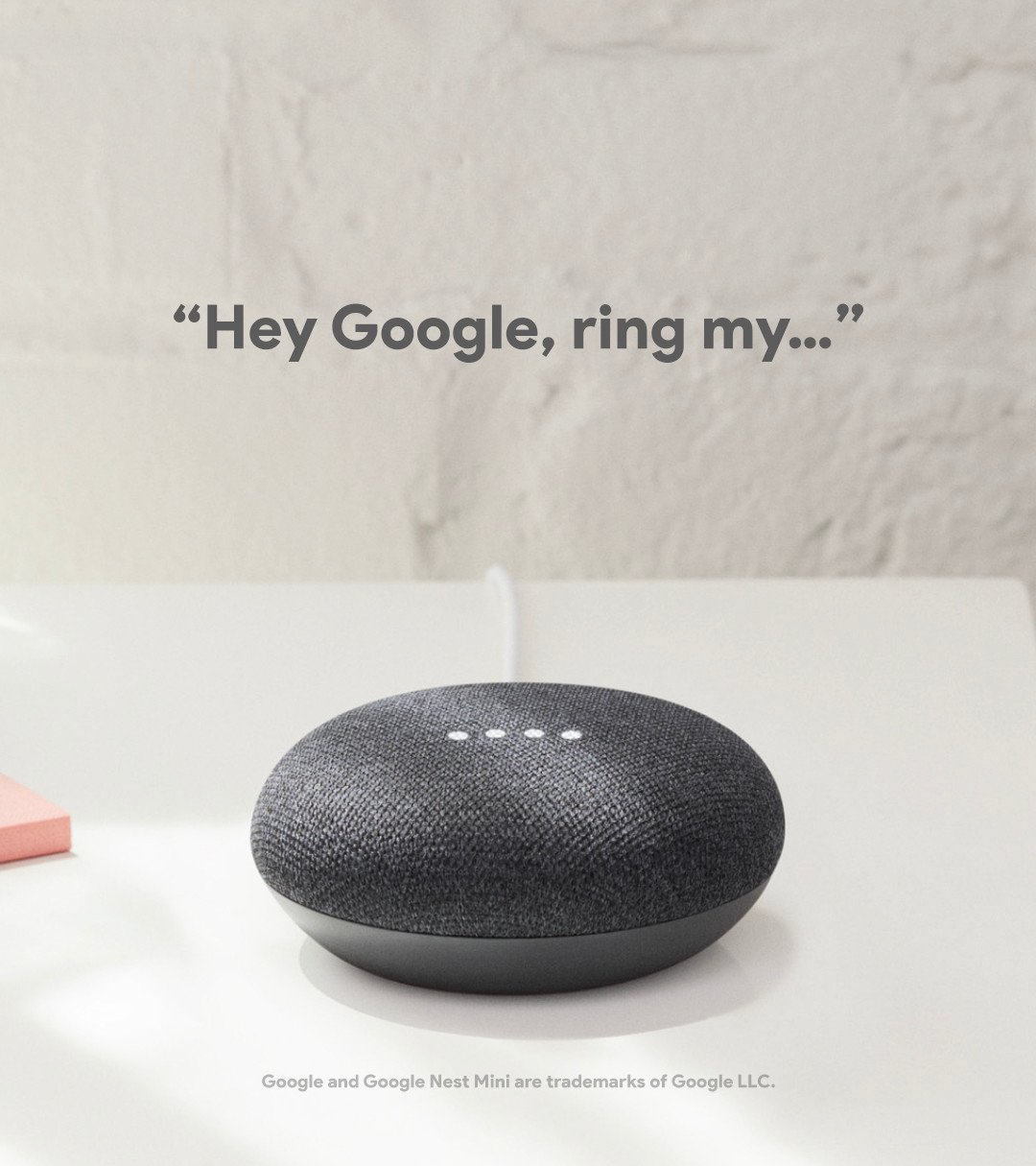
If you don’t have a Nest, you can still tell your Google Assistant what to do. However, although you won’t have to tap your phone, you’ll still need your phone with the Tile app running somewhere nearby so the Tile app can tell your Tile doohickey to ring.
FINAL WORD
No matter what you acquire this holiday season, whether for yourself or for others, Bluetooth trackers are still only part of the story. Whatever you’ve got (or intend to acquire) make sure it serves your needs, and consider letting whatever languishes in drawers and cabinets be a blessing to someone else via donation. Don’t keep what you don’t need. (But if you’re having trouble keeping track of what you do need, Bluetooth trackers are pretty cool.)
Paper Doll Organizes Boxing Day Downton Abbey-style with Give Back Box®
You’ve got boxes, right? After a weekend of giving and receiving gifts, you’re likely surrounded by boxes. Everywhere you turn, boxes. It’s practically a Day of Boxing! Well, actually…
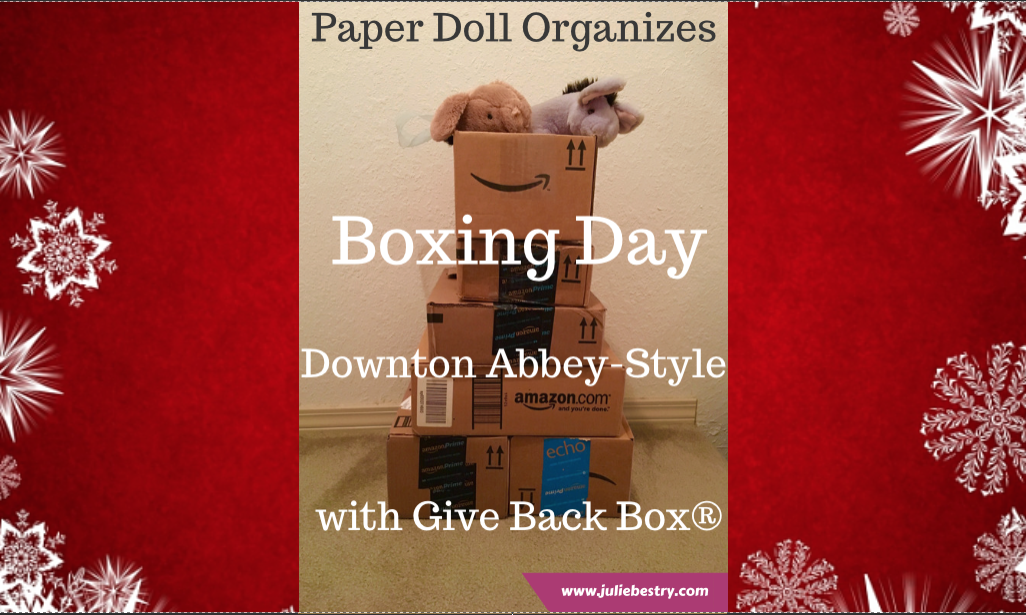
Boxing Day, observed on December 26th, the day after Christmas (and this year, the second day of Hanukkah), is a holiday popularly celebrated in the UK and various Commonwealth nations, many of which used to be British colonies. The history of the holiday is complex and widely debated, but traditionally, servants and tradespeople were given Christmas boxes on the day after Christmas, when they were granted leave to visit their own families and did not have to work. How very Downton Abbey of them.
Before you move along to another post, affecting a posh accent and saying, “I’m going upstairs to take off my hat,” I’d like to suggest a much more rewarding way to observe Boxing Day.
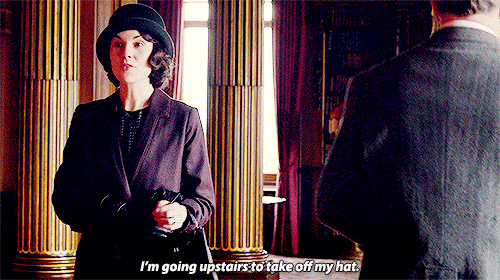
Give Back Box®, through a partnership with Amazon, Overstock.com, Ann Taylor, REI Co-Op, and more than a dozen other retailers, has found a solution that allows you to encourage yourself to pare down your excess possessions, bless others with donations of your largesse, and get those cardboard shipping boxes out of your house, all in one fell swoop.
![]()
THE MISSION STATEMENT
The purpose of Give Back Box® is to provide an effortless and convenient method of donating your used household items. Give Back Box not only provides an easy way to be part of a truly good cause, it also allows cardboard boxes a second life by recycling them and keeping them away from landfills to help improve our environment. So this is an all-round CSR & Sustainability solution that costs you literally nothing.
THE PROCESS
- Take your Amazon (or any other retail partner’s box), and empty out the goodies you’ve received. (You can also use a plain cardboard box, if you like.)
- Fill the box with donations of clothing, shoes, and various household goods. But please, no liquids, electronics, ammunition, or fragile or hazardous things! (And do check the pockets for any train tickets that might prove you innocent of murder.) Then seal up the package.
- Print a free pre-paid shipping label from Give Back Box’s site and affix it to the box. The cost is covered by Give Back Box’s partner retailers, most of whom have special Give Back Box pages on their sites, too.
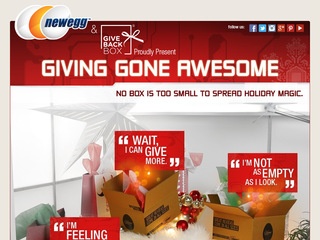 There’s no weight limit, so you can fill the box to the brim — and print as many labels as you need.
There’s no weight limit, so you can fill the box to the brim — and print as many labels as you need.
- Now, just send the package to Goodwill via UPS or the United States Postal Service at any UPS Store or post office, all at no cost to you. You can even request a free USPS pick-up of your package at your home, if the weather outside is not so delightful and you’d rather lounge about and have your lady’s maid, Anna, serve your meals in bed.
THE BENEFITS
Give Back Box box has a variety of benefits — personal, social, economic, and environmental.
You’ll make donations more often — You know you’re busy. You know your house is full of things you don’t use, don’t wear, or don’t want. (Honestly, what was Aunt Rosamund thinking?) You want to donate more things and more often, but the truth is that every time you find something in your home that you want to donate, you set it aside and forget about it. Maybe you have a donation station in your home, with the pile getting bigger and bigger, but it practically takes an act of Congress to get the donations out of your house, into your car, and to whatever non-profit you choose.
By making it free and convenient, Give Back Box prompts you to think about what you can let go of every single time you receive a box from one of their partner retailers.
Boom! There’s your habit! Get a box of stuff? Give a box of stuff!
That’s good for you, and it’s good for all the work that Goodwill does, providing job training and putting people to work in the local community. And people who want and need what you no longer have space or time to manage reap the benefits, too!
It’s also sustainable. About 30 million tons of retailers’ cardboard box material is zooming around the earth each year. By following the principles of “reduce, reuse, and recycle,” Give Back Box and its partners are helping you clean out your house and helping us all clean up the environment.
Even the Dowager Countess would be excited!

Still have questions? Read through the Give Back Box page of frequently asked questions, and check out this little video.

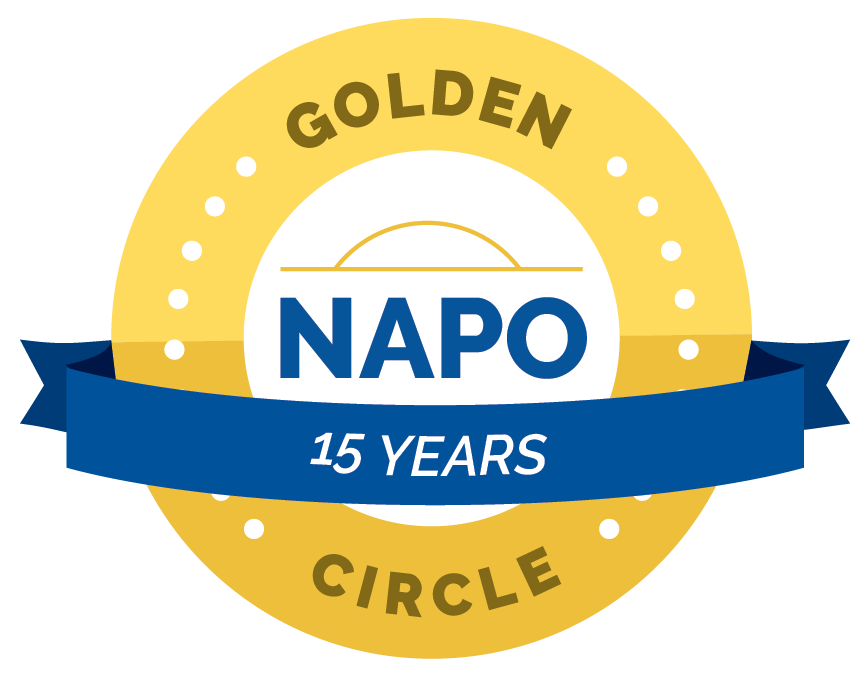
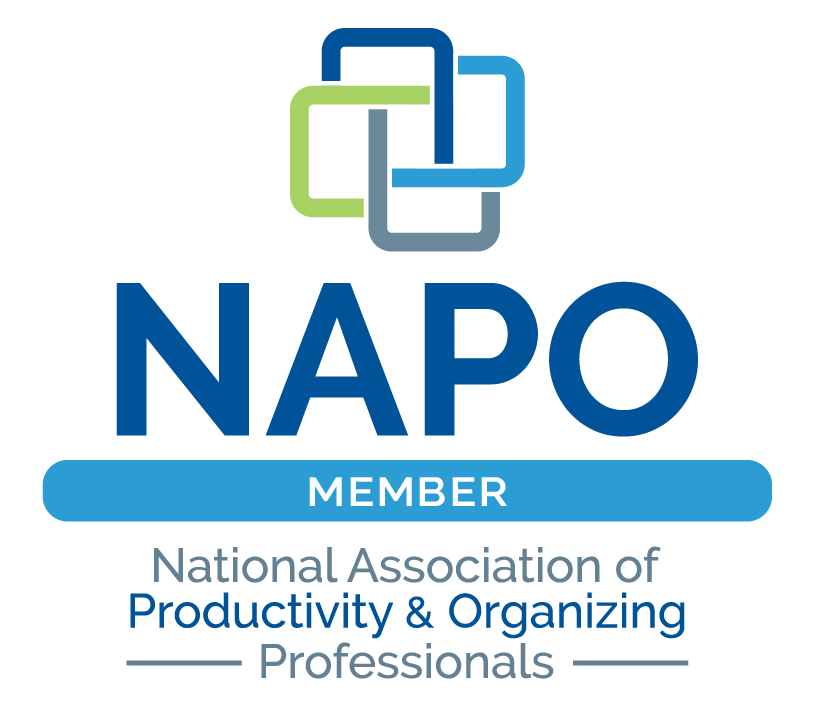

Follow Me